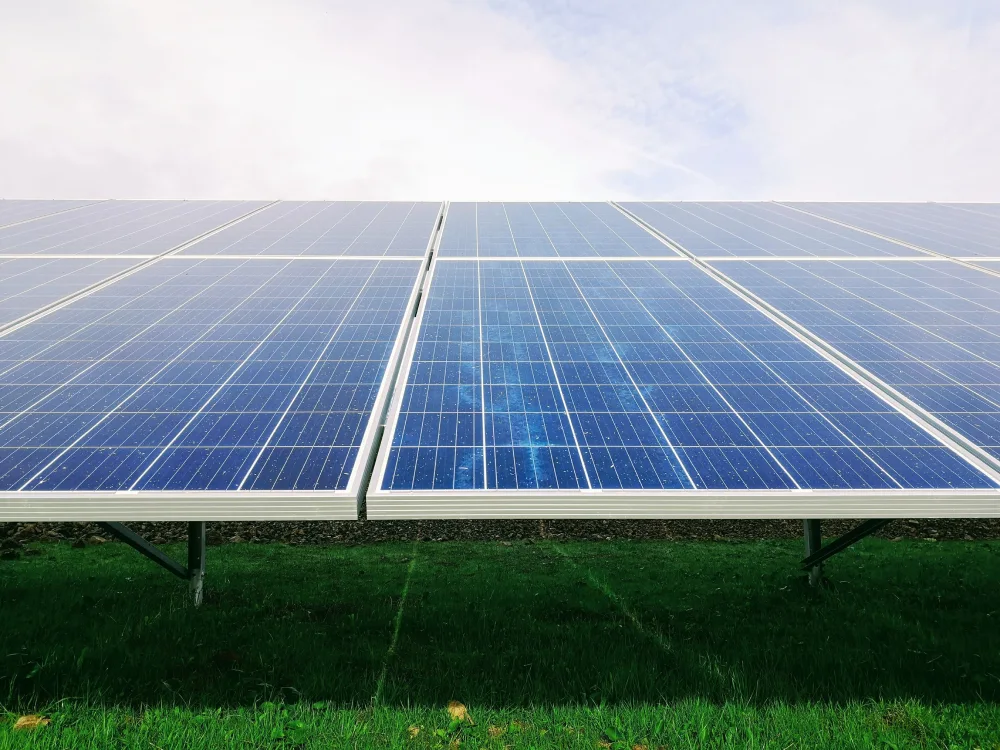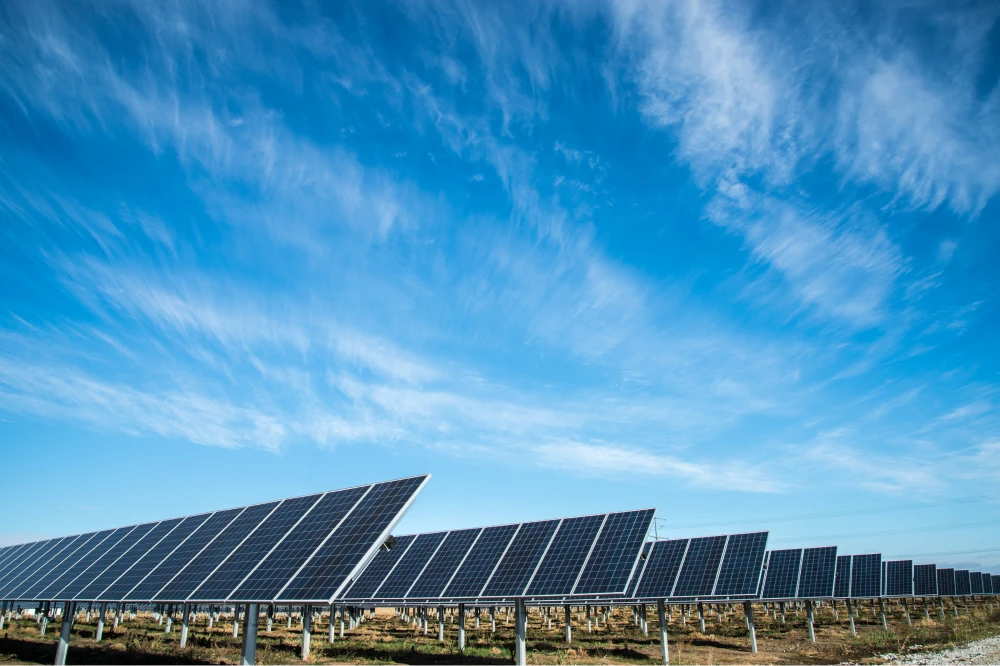The Largest Solar Farms in Texas: 2025
3 minute readTexas's largest solar farms, upcoming projects, and their impact on grid reliability.
Home > Learning Center > Energy Production > What Is Solar Energy?
5 minute read • Last update August 2024

Solar energy or solar power is energy that is derived from the sun’s rays. Solar panels harness and convert the heat and light energy of the sun into usable electrical energy, which can then be transmitted to power homes and businesses. This is a green and sustainable source of energy because sunlight is always coming to the Earth. Every day, the sun emits an immense amount of energy in the form of photons. These photons have the potential to produce heat or induce electrical currents when they interact with matter.
Solar panels, often referred to as photovoltaic (PV) panels, are devices designed to capture sunlight and convert it into electricity. These panels consist of a collection of solar cells, which are typically made from semiconductor materials like silicon. Each solar cell is composed of two slices of semi-conducting material, forming a metaphorical sandwich. When the sunlight interacts with these cells, it stimulates a dynamic flow of electrons, generating an electric current.
This current can then be used to power electrical devices or stored for later use. Solar panels come in various sizes and types, ranging from small portable panels used for camping or remote applications to large arrays that can power entire homes or even feed electricity back into the grid.
Solar panels work by allowing photons, or particles of light, to knock electrons free from atoms, generating a flow of electricity. This process is known as the photovoltaic effect. When sunlight strikes the solar cells within a panel, it excites the electrons within them. This excitement of electrons creates an electric current. Through a series of processes, this electricity is then channeled and can be used to power everything from household appliances to large industrial machinery.

Yes. The sun has been shining for billions of years and is expected to continue doing so for billions more. Its vast energy output remains consistent, making it a reliable and sustainable source of power. Unlike fossil fuels, which are finite and deplete over time, solar energy will remain accessible as long as the sun continues to shine.
Let’s explore the pros and cons of solar power.
Solar energy is derived from a renewable source—the sun. As long as the sun continues to shine, we can harness its energy, making solar power a sustainable solution for our ever-increasing energy needs. By incorporating solar energy into our energy mix, we can combat climate change by reducing greenhouse gas emissions and actively contribute to a cleaner and healthier environment for ourselves and future generations.
One of the benefits of solar energy production is its clean operation. Unlike fossil fuel-based power generation, solar energy production releases no harmful air pollutants like sulfur dioxide, nitrogen oxides, or particulate matter. As a result, air quality is cleaner, and health problems associated with air pollution are decreased.
While the initial investment for solar installations might be substantial, the long-term savings on electricity bills can be significant. Over time, many homeowners find that their solar panels pay for themselves.
By installing solar panels, homeowners and businesses can produce their own electricity. Doing so reduces dependence on utility companies and can even lead to energy self-sufficiency.
The growing solar industry has created numerous jobs, from manufacturing and research to installation and maintenance. As of 2022, there are over 260,000 people working in the solar energy industry in the United States.
Unlike traditional power plants that consume vast amounts of water for cooling purposes, solar power plants require minimal water usage. This decrease helps promote sustainable water practices that reduce the strain on freshwater ecosystems.
By addressing these concerns and continuing to invest in research and innovation, we can further enhance the overall sustainability of solar energy and ensure its long-term benefits for our environment.
Solar energy production is dependent on sunlight, which isn’t constant. Nighttime and cloudy days can reduce energy production, necessitating the need for energy storage solutions or back up power sources.
While rooftop solar installations have minimal land impact, large solar farms can require significant amounts of land, potentially displacing natural habitats.
The initial investment required for solar installations can be a barrier for many, though costs have decreased and various incentives are available.
The production of solar panels requires energy, often sourced from non-renewable resources, leading to emissions. However, it is worth noting that advancements are being made in manufacturing processes to reduce the environmental impact. The industry is also exploring alternative materials and cleaner energy sources for solar panel production.
As solar panels end their lifespan, disposing or recycling them becomes challenging. Currently, efforts are underway to develop effective recycling methods for solar panels, ensuring that valuable materials can be recovered and reused. The goal is to minimize waste and create a more sustainable lifecycle for solar energy systems.
In 2022, the United State generated 146 billion kWh of electricity from solar energy sources. This makes up about 3% of electricity generated in the U.S.
The adoption of solar energy in the U.S. has been growing rapidly. Government incentives, decreasing installation costs, and a heightened awareness of environmental issues have all contributed to this growth. The U.S. continues to invest in research to improve solar technology efficiency and accessibility, positioning itself as a leader in the global shift toward renewable energy.
According to ERCOT, Texas has the capacity to produce a maximum of over 22,000 MW of electricity through solar panel farms in the state.

Solar energy’s ascent as a leading renewable source has ushered in transformative changes on a global scale. Environmentally, it has been instrumental in curtailing greenhouse gas emissions, aiding the fight against climate change. Additionally, by reducing the world’s reliance on fossil fuels, solar energy has led to cleaner air and the conservation of natural habitats that would otherwise be compromised by fossil fuel extraction.
Economically, the solar sector has been a job creation powerhouse, generating millions of positions worldwide. It has also played a pivotal role in diversifying energy sources, reducing dependence on imported fuels, and thus enhancing energy security. As solar technology becomes more advanced and affordable, both consumers and businesses are reaping the financial benefits.
On the technological front, the growing demand for solar solutions has driven significant advancements in photovoltaic cells and storage systems. Furthermore, solar energy’s adaptability allows even off-grid, remote regions to produce their own electricity, marking a shift towards more decentralized energy systems. This renewable source also seamlessly integrates with other emerging technologies, such as electric vehicles and smart grids.
Socially and politically, solar energy has been transformative. It has brought electricity and its associated benefits to remote areas, elevating the quality of life. The rapid growth of the solar industry has also influenced governments worldwide to implement policies that favor renewable energy adoption. This shift, coupled with the industry’s growth, has heightened public awareness about the importance of transitioning to sustainable energy sources.
The influence of solar energy is profound, touching multiple facets of society and positioning it as a cornerstone in the journey toward a more sustainable future.
Interested in powering your home with renewable electricity? All BKV Energy plans start at 29% renewable and you can choose 100% renewable energy as well. Enter your zip code to find plans near you.
Graham Lumley, Digital Marketing Manager at BKV Energy, leads digital and traditional marketing strategies, focusing on educating Texans about the state's deregulated energy market. With over 8 years of marketing experience, he creates content to help consumers understand and save on their energy bills, bringing a fresh and dynamic approach to the industry.

Texas's largest solar farms, upcoming projects, and their impact on grid reliability.

Discover how Texas dominates U.S. wind power with massive utility-scale projects.
Get $50 off your electric bill!
Use code BKVEJOINUS50
Enter your zip code to shop BKV Energy's affordable, fixed-rate Texas electricity plans. Use the promo code for $50 off your electric bill.